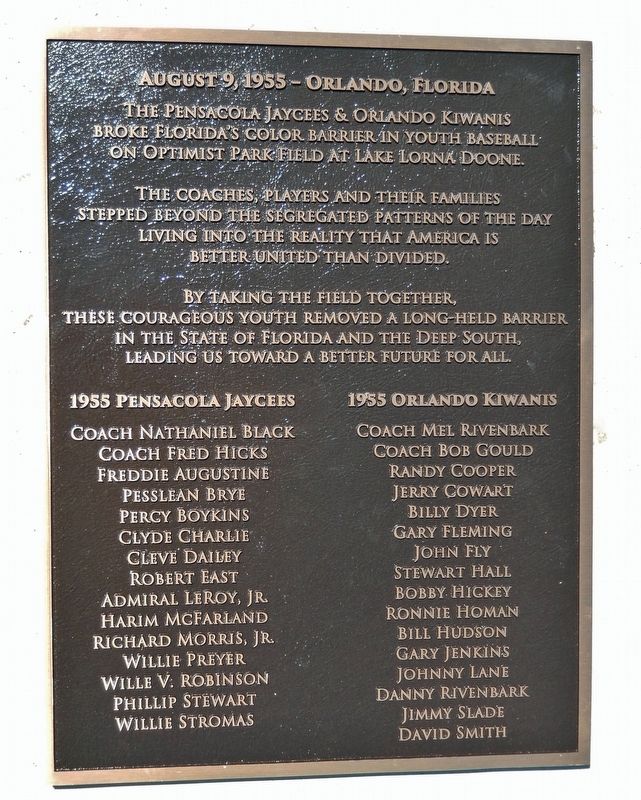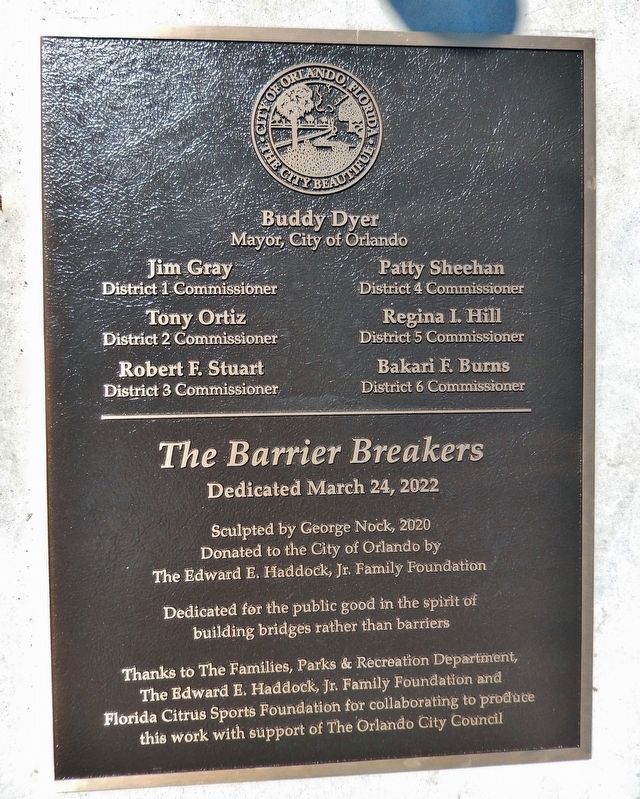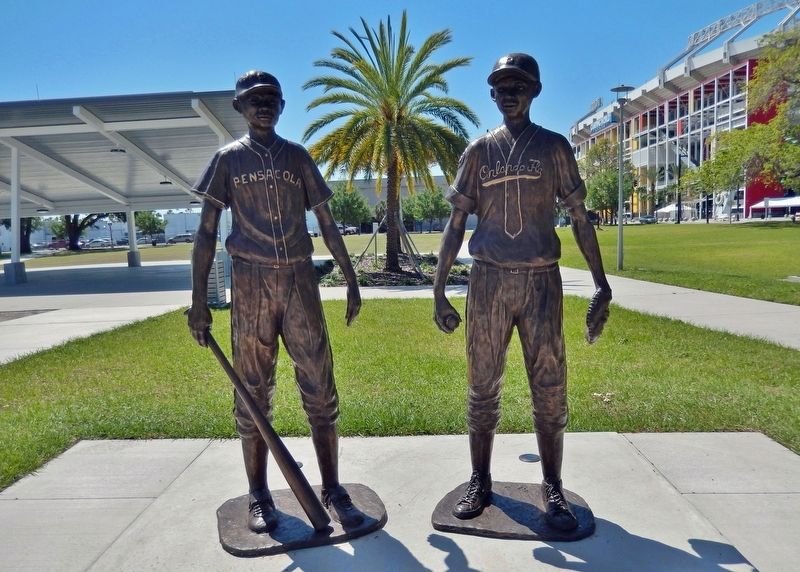Orlando in Orange County, Florida — The American South (South Atlantic)
The Barrier Breakers
August 9, 1955 — Orlando, Florida
The Pensacola Jaycees & Orlando Kiwanis broke Florida’s color barrier in youth baseball on Optimist Park Field at Lake Lorna Doone.
The coaches, players and their families stepped beyond the segregated patterns of the day living into the reality that America is better united than divided.
By taking the field together, these courageous youth removed a long-held barrier in the State of Florida and the Deep South, leading us toward a better future for all.
Coach Nathaniel Black • Coach Fred Hicks • Freddie Augustine • Pesslean Brye • Percy Boykins • Clyde Charlie • Cleve Dailey • Robert East • Admiral LeRoy, Jr. • Harim McFarland • Richard Morris, Jr. • Willie Preyer • Wille V. Robinson • Phillip Stewart • Willie Stromas
1955 Orlando Kiwanis
Coach Mel Rivenbark • Coach Bob Gould • Randy Cooper • Jerry Cowart • Billy Dyer • Gary Fleming • John Fly • Stewart Hall • Bobby Hickey • Ronnie Homan • Bill Hudson • Gary Jenkins • Johnny Lake • Danny Rivenbank • Jimmy Slade • David Smith
————————
Buddy Dyer
Mayor, City of Orlando
Jim Gray, District 1 Commissioner
Tony Ortiz, District 2 Commissioner
Robert F. Stuart, District 3 Commissioner
Patty Sheehan, District 4 Commissioner
Regina I. Hill, District 5 Commissioner
Bakari F. Burns, District 6 Commissioner
The Barrier Breakers
Dedicated March 24, 2022
Sculpted by George Nock, 2020
Donated to the City of Orlando by
The Edward E. Haddock, Jr. Family Foundation
Dedicated for the public good in the spirit of
building bridges rather than barriers
Thanks to The Families, Parks & Recreation Department,
The Edward E. Haddock, Jr. Family Foundation and
Florida Citrus Sports Foundation for collaborating to produce
this work with support of The Orlando City Council
————————
About the Artist — George Nock
George Verdell Nock was born in Baltimore, Maryland on March 4, 1946. At a young age George demonstrated exceptional talent as both an artist and an athlete, sketching, sculpting and painting through high school while playing basketball and football.
In 1964 Nock earned a football scholarship to Morgan State University and studied psychology. In December 1966, the Morgan State Bears earned a bid to the Tangerine Bowl where Nock and his teammates broke Central Florida’s long-standing color barrier in collegiate football. In doing so, George Nock exhibited grace and courage during a time of social tension and uncertainty.
As star running back and captain for the Bears, Nock received All-American honorable mention, All-CIAA, All-State and All American-Black Colleges honors. He was drafted to the NFL in 1969 and played five years with the New York Jets and Washington Redskins.
Nock led youth development work in Washington, DC where he mentored teens and re-engaged his love for art. He channeled his natural strength and graceful athletic skill to create tactile and delicate sculptural forms in the raw and energetic tradition of Rodin.
Mr. Nock felt a personal connection with The Barrier Breakers commission. Reflecting on the sculpture and his own participation in civil rights work, he wrote, “Of all the public projects I’ve completed, I am extremely proud to be a part of this historical venture.”
The Barrier Breakers sculpture is George Nock’s final piece of public art. While traveling to Orlando in October 2020 to deliver the sculpture and design its installation, Mr. Nock contracted COVID-19 and succumbed to complications on November 22, 2020.
We grieve his passing and find it fitting that the monument should honor both the accomplishments of the 1955 Pensacola Jaycees and Orlando Kiwanis and those of George Nock, himself. Their lives stand together before us as an inspiration that we too, in our time, might embody the courage and the grace of The Barrier Breakers.
Erected 2022 by Edward E. Haddock, Jr. Family Foundation.
Topics. This historical marker is listed in these topic lists: African Americans • Arts, Letters, Music • Parks & Recreational Areas • Sports. A significant historical date for this entry is August 9, 1955.
Location. 28° 32.465′ N, 81° 24.06′ W. Marker is in Orlando, Florida, in Orange County. Marker can be reached from Rio Grande Avenue just north of West Church Street, on the right when traveling north. Marker and sculpture are located on the west side of Lake Lorna Doone Park, between the pavilion and basketball courts. Touch for map. Marker is at or near this postal address: 1519 West Church Street, Orlando FL 32805, United States of America. Touch for directions.
Other nearby markers. At least 8 other markers are within walking distance of this marker. The Mighty Trees of Lake Lorna Doone (about 300 feet away, measured in a direct line); Rev. Martin Luther King, Jr. (approx. 0.3 miles away); Tinker Field History Plaza (approx. 0.3 miles away); Clark C. Griffith (approx. 0.3 miles away); Harmon Killebrew at Tinker Field (approx. 0.3 miles away); a different marker also named Rev. Martin Luther King, Jr. (approx. 0.3 miles away); The End of an Era (approx. 0.3 miles away); Mayor Bob Carr and The New Stadium (approx. 0.3 miles away). Touch for a list and map of all markers in Orlando.
Also see . . .
1. Orlando unveils monument representing the first integrated Little League game in the south.
In 1955, Orlando hosted Pensacola, an all-Black team, for the Little League state tournament. One of the players Stewart Hall, who was just 12-years-old at the time, returned for the unveiling of the statue. He said now, in his 70s, seeing the statue means so much. And he hopes others feel inspired by their story.(Submitted on March 28, 2022, by Cosmos Mariner of Cape Canaveral, Florida.)
2. 1955 Pensacola Jaycees and Orlando Kiwanis Little League Teams, Barrier Breakers.
The Pensacola Jaycees were the first all-black Little League team to play the Orlando Kiwanis an all-white Little League team. In 1955 when racial segregation defined the south, two groups of twelve-year-old boys stepped onto a baseball field in an act of cultural defiance that changed the course of history. A documentary film, Long Time Coming, was produced and featured the players who were there that day on the field. In addition to sharing the story, the players speak about their experiences before, during, and after the game.(Submitted on March 28, 2022, by Cosmos Mariner of Cape Canaveral, Florida.)
3. Pensacola Little League team's historic game is subject of new documentary.
The Pensacola Jaycees All-Star team went to the Little League State Championship in Orlando in August 1955 as the regional champions from Northwest Florida. That's because the all-white teams from the Panhandle didn't want to play against an all-black team, like the Pensacola Jaycees, and instead forfeited the regional games. And when the Pensacola Jaycees arrived in Orlando, they were sent home by 12-year-old pitcher Johnny Lane, who silenced the Pensacola bats in a 5-0 Orlando win. But the score of the game doesn't matter to the history books. Because the game was a landmark civil rights milestone — the first time in Little League history that an all-black team played an all-white team in the segregated Deep South.(Submitted on March 28, 2022, by Cosmos Mariner of Cape Canaveral, Florida.)
4. Long Time Coming: A 1955 Baseball Story.
In 1955, when racial segregation defined the South, two groups of twelve-year-old boys stepped onto a baseball field in a non-violent act of cultural defiance that would change the course of history.(Submitted on March 28, 2022, by Cosmos Mariner of Cape Canaveral, Florida.)
Credits. This page was last revised on March 28, 2022. It was originally submitted on March 28, 2022, by Cosmos Mariner of Cape Canaveral, Florida. This page has been viewed 249 times since then and 22 times this year. Photos: 1, 2, 3, 4, 5. submitted on March 28, 2022, by Cosmos Mariner of Cape Canaveral, Florida.




